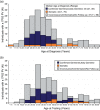A substantial proportion of apparently heterozygous TP53 pathogenic variants detected with a next-generation sequencing hereditary pan-cancer panel are acquired somatically
- PMID: 31490007
- PMCID: PMC6972517
- DOI: 10.1002/humu.23910
A substantial proportion of apparently heterozygous TP53 pathogenic variants detected with a next-generation sequencing hereditary pan-cancer panel are acquired somatically
Abstract
Previous analysis of next-generation sequencing (NGS) hereditary pan-cancer panel testing demonstrated that approximately 40% of TP53 pathogenic and likely pathogenic variants (PVs) detected have NGS allele frequencies between 10% and 30%, indicating that they likely are acquired somatically. These are seen more frequently in older adults, suggesting that most result from normal aging-related clonal hematopoiesis. For this analysis, apparent heterozygous germline TP53 PV carriers (NGS allele frequency 30-70%) were offered follow-up testing to confirm variant origin. Ninety-eight probands had samples submitted for follow-up family member testing, fibroblast testing, or both. The apparent heterozygous germline TP53 PV was not detected in 32.6% (15/46) of submitted fibroblast samples, indicating that it was acquired somatically, either through clonal hematopoiesis or via constitutional mosaicism. Notably, no individuals with confirmed germline or likely germline TP53 PVs met classic Li-Fraumeni syndrome (LFS) criteria, only 41% met Chompret LFS criteria, and 59% met neither criteria, based upon provider-reported personal and family cancer history. Comprehensive reporting of TP53 PVs detected using NGS, combined with follow-up analysis to confirm variant origin, is advised for clinical testing laboratories. These findings underscore the investment required to provide individuals and family members with clinically accurate genetic test results pertaining to their LFS risk.
Keywords: Li-Fraumeni syndrome; TP53; acquired somatically; hereditary pan-cancer gene panel; next-generation sequencing; pathogenic variant.
© 2019 The Authors. Human Mutation Published by Wiley Periodicals, Inc.
Conflict of interest statement
All authors are employed by Myriad Genetic Laboratories, Inc. and receive salaries as compensation.
Figures



Similar articles
-
Apparently Heterozygous TP53 Pathogenic Variants May Be Blood Limited in Patients Undergoing Hereditary Cancer Panel Testing.J Mol Diagn. 2020 Mar;22(3):396-404. doi: 10.1016/j.jmoldx.2019.12.003. Epub 2019 Dec 24. J Mol Diagn. 2020. PMID: 31881331
-
TP53 germline testing and hereditary cancer: how somatic events and clinical criteria affect variant detection rate.Genome Med. 2025 Jan 14;17(1):3. doi: 10.1186/s13073-025-01429-5. Genome Med. 2025. PMID: 39810221 Free PMC article.
-
Suspected Germline TP53 Variants and Clonal Hematopoiesis of Indeterminate Potential: Lessons Learned From a Molecular Tumor Board.Oncologist. 2023 Jul 5;28(7):624-627. doi: 10.1093/oncolo/oyad105. Oncologist. 2023. PMID: 37159554 Free PMC article.
-
Li-Fraumeni syndrome: not a straightforward diagnosis anymore-the interpretation of pathogenic variants of low allele frequency and the differences between germline PVs, mosaicism, and clonal hematopoiesis.Breast Cancer Res. 2019 Sep 18;21(1):107. doi: 10.1186/s13058-019-1193-1. Breast Cancer Res. 2019. PMID: 31533767 Free PMC article. Review.
-
Current review of TP53 pathogenic germline variants in breast cancer patients outside Li-Fraumeni syndrome.Hum Mutat. 2018 Dec;39(12):1764-1773. doi: 10.1002/humu.23656. Epub 2018 Oct 3. Hum Mutat. 2018. PMID: 30240537 Review.
Cited by
-
Patterns of mosaicism for sequence and copy-number variants discovered through clinical deep sequencing of disease-related genes in one million individuals.Am J Hum Genet. 2023 Apr 6;110(4):551-564. doi: 10.1016/j.ajhg.2023.02.013. Epub 2023 Mar 17. Am J Hum Genet. 2023. PMID: 36933558 Free PMC article.
-
Diagnostic and Practical Challenges in Applying National Comprehensive Cancer Network Guidelines for Suspected Pathogenic TP53 Mosaicism.JCO Precis Oncol. 2024 Jul;8:e2400006. doi: 10.1200/PO.24.00006. JCO Precis Oncol. 2024. PMID: 38991177 Free PMC article.
-
Suggested application of HER2+ breast tumor phenotype for germline TP53 variant classification within ACMG/AMP guidelines.Hum Mutat. 2020 Sep;41(9):1555-1562. doi: 10.1002/humu.24060. Epub 2020 Jun 12. Hum Mutat. 2020. PMID: 32485079 Free PMC article.
-
Paired Tumor-Normal Sequencing Provides Insights Into the TP53-Related Cancer Spectrum in Patients With Li-Fraumeni Syndrome.J Natl Cancer Inst. 2021 Nov 29;113(12):1751-1760. doi: 10.1093/jnci/djab117. J Natl Cancer Inst. 2021. PMID: 34240179 Free PMC article.
-
Increased frequency of clonal hematopoiesis of indeterminate potential in Bloom syndrome probands and carriers.Haematologica. 2025 Jan 1;110(1):187-192. doi: 10.3324/haematol.2024.285239. Haematologica. 2025. PMID: 39049596 Free PMC article. No abstract available.
References
-
- de Andrade, K. C. , Mirabello, L. , Stewart, D. R. , Karlins, E. , Koster, R. , Wang, M. , … Achatz, M. I. (2017). Higher‐than‐expected population prevalence of potentially pathogenic germline TP53 variants in individuals unselected for cancer history. Human Mutation, 38(12), 1723–1730. 10.1002/humu.23320 - DOI - PMC - PubMed
Publication types
MeSH terms
Substances
LinkOut - more resources
Full Text Sources
Medical
Research Materials
Miscellaneous

